Why does Japan's history captivate the world so profoundly? A Japanese history timeline shows how the nation has changed from ancient times to today. This visual tool is essential for understanding key events, cultural shifts, and important figures.
Using a timeline helps make learning more interactive. It is a practical way to explore and study history. Later in this article, you will learn how to create your own historical timelines using EdrawMind. This guide will help you make effective and insightful timelines. Now, let's explore the fascinating history of Japan.
In this article
History Timeline of Japan
A history timeline of Japan is a great educational resource. It simplifies complex historical sequences, making them easier to understand.
- Students can quickly grasp the order of events.
- Historians can see how different periods are connected.
- Enthusiasts find a visual timeline engaging and easy to use, giving a clear picture of Japan's rich past.
To appreciate Japan's rich history, we must explore its key periods. Each era, from ancient times to modern days, shaped the nation. Let's look at the major periods in the Japan's history timeline and see how they influenced Japan's development.
Jomon Period (10,000 – 300 BC)
The Jomon Period is named after the cord-marked pottery found across 224 sites in Honshu and Kyushu. This era represents the pre-agricultural society of Japan. It is characterized by a hunter-gatherer lifestyle. The distinctive pottery style reflects the complex social and ritual practices of the time.
Yayoi Period (900 BC – 300 AD)
The Yayoi Period marks a significant shift in Japanese history, known as the Iron Age of Japan. This era saw the introduction of rice agriculture. The name Yayoi comes from a district in Tokyo where pottery from this period was first discovered. Agricultural advancements led to increased population density and the development of more complex social hierarchies.
Kofun Period (300 AD – 538 AD)
Named after the kofun or burial mounds built for the ruling elite, the Kofun Period signifies the emergence of a more centralized political structure. These tombs were constructed for powerful clan leaders. They are indicative of the social stratification and political consolidation occurring at this time.
Asuka Period (538 AD – 710 AD)
The Asuka Period is pivotal in Japanese history. It holds significance due to the introduction of Buddhism from Korea. It profoundly influences Japanese culture, art, and politics. This period is marked by significant artistic and socio-political changes. It includes the establishment of a more structured governmental system.
Nara Period (710 AD – 794 AD)
The Nara Period is notable for the establishment of Japan’s first permanent capital at Heijo-kyo, modern-day Nara. This era saw the codification of laws and the consolidation of imperial power. The population was affected by various natural disasters and epidemics. However, this period also witnessed the flourishing of literature, culture, and Buddhist art.
Heian Period (794 AD – 1185 AD)
During the Heian Period, the imperial court moved to Heian-kyo, present-day Kyoto. This era is known for its cultural achievements, especially in literature and the arts. The Tale of Genji, written by Murasaki Shikibu, is a famous literary work from this time. Politically, the period saw the rise and fall of the Fujiwara clan’s influence.
Kamakura Period (1185 AD – 1333 AD)
The Kamakura Period began with Minamoto no Yoritomo establishing a shogunate in Kamakura. This era is marked by the samurai's rise to power and the Mongol invasions of Japan in 1274 and 1281. The period ended with the fall of the Kamakura shogunate and the restoration of imperial rule.
Muromachi Period (1333 AD – 1573 AD)
The Muromachi Period was marked by political instability and the emergence of regional daimyos. The Ashikaga shogunate faced numerous internal conflicts. It included the Onin War (1467-1477), which led to the Warring States period.
Azuchi-Momoyama Period (1573 AD – 1603 AD)
This period saw the reunification of Japan under powerful warlords like Oda Nobunaga and Toyotomi Hideyoshi. Hideyoshi’s campaigns to conquer Korea were unsuccessful. However, his domestic policies laid the groundwork for a unified Japan. The period ended with the Battle of Sekigahara in 1600. It led to Tokugawa Ieyasu’s establishment of the Tokugawa shogunate.
Edo Period (1603 AD – 1868 AD)
The Edo Period was characterized by over 250 years of relative peace and stability under the Tokugawa shogunate. Japan adopted a policy of national isolation (sakoku), limiting foreign influence and trade. This era saw the flourishing of urban culture. The period ended with the Meiji Restoration. This restored imperial rule and initiated Japan's modernization.
Meiji Period (1868 AD – 1912 AD)
The Meiji Period marked Japan’s transformation into a modern industrial nation. The Meiji Restoration ended the shogunate, and the emperor's power was restored. Japan adopted Western technologies and administrative reforms. This helped Japan to industrialize and become a significant world power. The period saw the introduction of compulsory education.
Showa Period (1926 AD – 1989 AD)
Emperor Hirohito's reign during the Showa Period encompassed significant events. It includes Japan's militarization, participation in World War II, and subsequent defeat. Post-war, Japan underwent a remarkable economic recovery. It became one of the world's leading economies. The Tokyo 1964 Olympics symbolized Japan's post-war recovery and economic success.
Heisei Period (1989 AD – 2019 AD)
The Heisei Period was marked by economic stagnation following the burst of the bubble economy in the early 1990s. Japan continued to be a global leader in technology and innovation. Notable events include the 1995 sarin gas attack on the Tokyo subway by the Aum Shinrikyo cult and numerous natural disasters. It includes the 2011 Tohoku earthquake and tsunami.
How to Make a History Timeline
Creating a timeline is easy with EdrawMind.
EdrawMind is a powerful tool for crafting detailed and visually appealing timelines. It helps users map out events clearly and effectively. This software is perfect for illustrating the timeline history of Japan. EdrawMind’s user-friendly features make it simple to add dates, descriptions, and images.
Next, let's explore how you can use EdrawMind to create your own historical timelines.
How to Make a Basic History Timeline in EdrawMind
Step 1
Download EdrawMind to create your timeline. You can also try EdrawMind online. It is available on Windows, MacOS, iOS, Linux, and Android. If you want to create a timeline, EdrawMind is perfect for you.

Step 2
Once EdrawMind is installed, start creating your timeline by clicking the Create button. From there, choose the Local Mind Map to open a blank canvas. This step sets the stage for you to begin plotting the events of your history timeline.

Step 3
To jumpstart your timeline creation, navigate to the Gallery section. Here, type timeline into the search bar to explore available templates. Select a template that fits your needs. Click Duplicate to start personalizing it for your Japan history timeline.

Step 4
To enrich your timeline, click on the Topic option. Here, you can add Parent Topics to organize major historical eras. Moreover, Topic Before option helps to insert events in chronological order. These functions help structure your timeline clearly. It ensures each event connects logically within your historical narrative.

Step 5
To effectively connect different eras in your Japan history timeline, use EdrawMind's Relationship option. This tool allows you to draw connections between various topics. It illustrates the flow and relationships of historical events clearly.
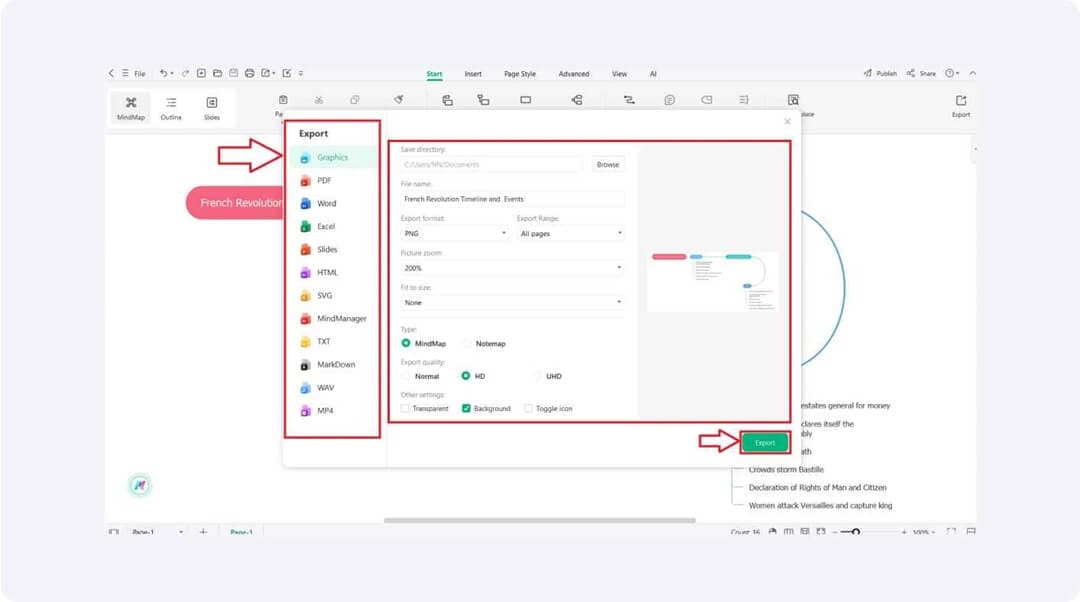
Step 6
Once your Japan history timeline is complete, exporting it is simple. Go to File and select Export. A window will appear where you can choose your preferred format. Select the desired format and click Export to save your timeline.
How to Customize a History Timeline
To transform your Japan history timeline into a visually striking and memorable document, EdrawMind offers several powerful tools.
Each method enhances the design of your timeline, from floating bars and clip art to real-time collaboration and custom layouts. Next, we'll explore these features in detail to help you create a history timeline that is informative and aesthetically pleasing.
Floating Bar Customization
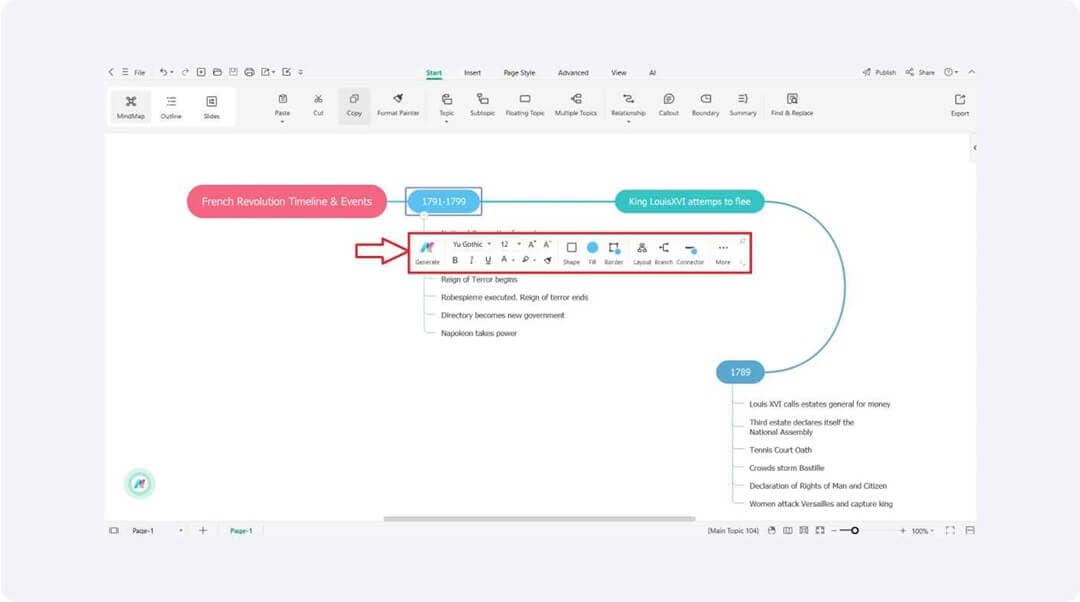
Use the floating bar to make your history timeline visually appealing. This feature lets you modify branches, connectors, borders, and shapes of your topics. These adjustments can dramatically enhance the look of your timeline. It makes it both attractive and easy to understand.
Clip Art Enhancement
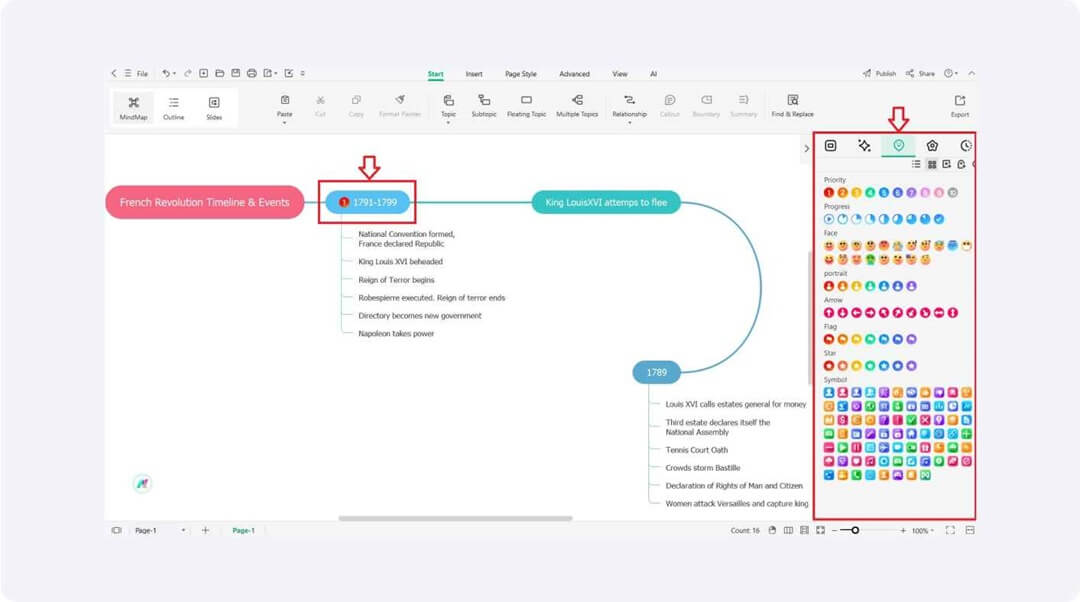
Make your history timeline more engaging by incorporating clip art. These visuals can highlight key events and periods. Clip art adds interest and emphasis to different sections of your timeline. This method not only enhances visual appeal but also helps viewers remember important historical milestones.
Real-time Collaboration Feature
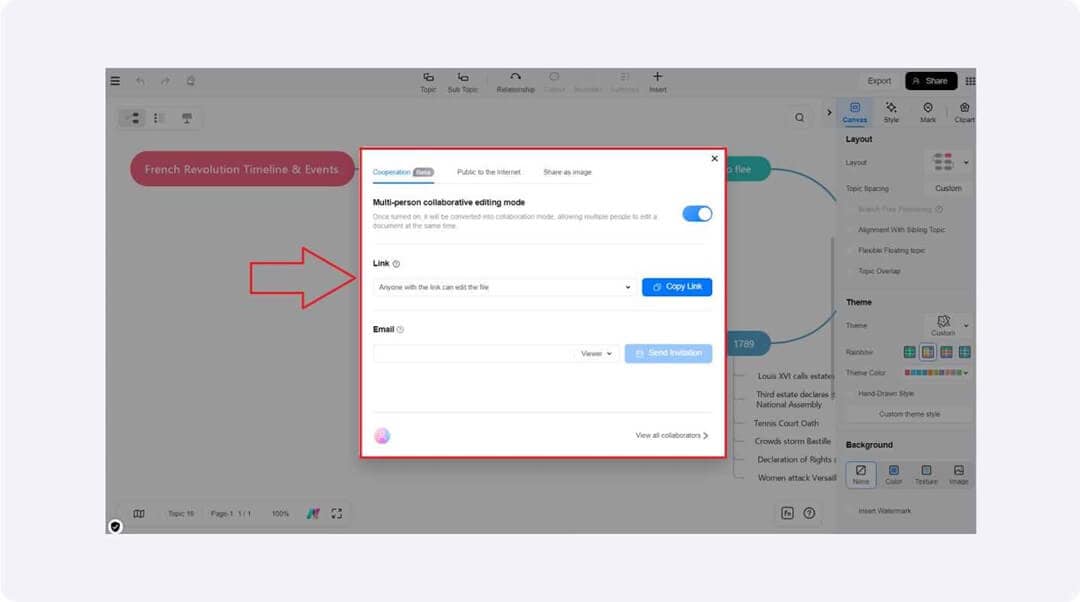
Improve your history timeline with EdrawMind's real-time collaboration. Go to Share and allow multiple users to edit the document simultaneously. This feature enables collective input, helping to refine and enrich your timeline visually and informatively.
Layout and Themes
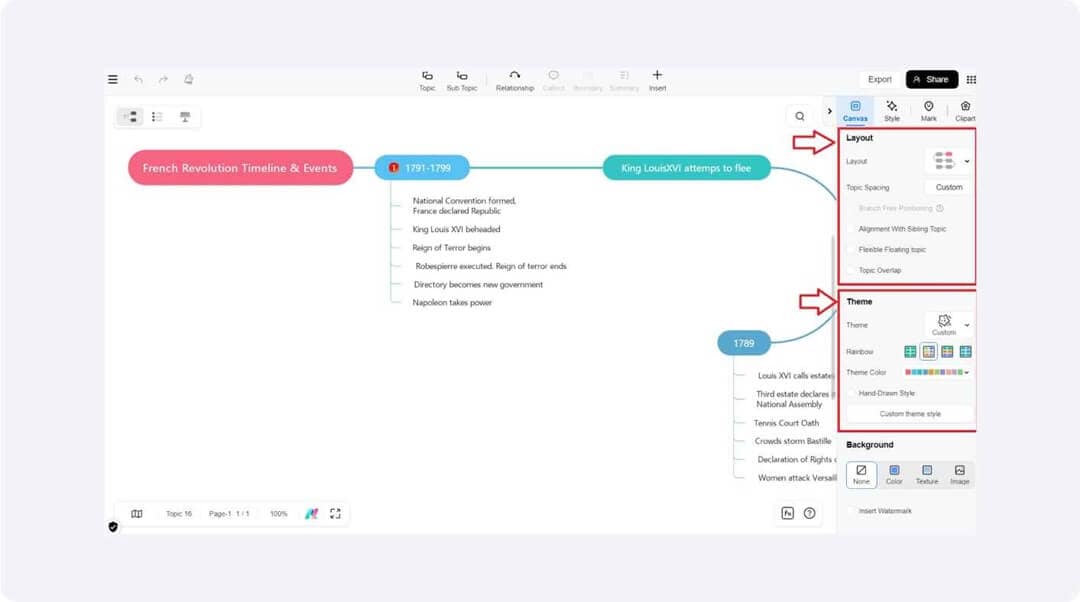
To make your history timeline visually appealing, utilize EdrawMind’s layout and theme options. Click the arrow on the right to access the side panel. Here, you can choose from a variety of layouts and themes that best suit your timeline's style. This feature allows you to easily customize the appearance of your timeline.




 below.
below.  below.
below. 

